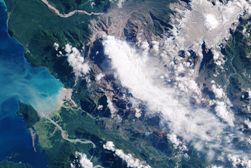
A new study of an unusual rhyolitic volcano, which erupted unexpectedly in Chile last April, has raised concerns over hazard warning, reports Ian Randall.
Geoscientist Online 29 October 2009
In Chaitén town, North Patagonia, on the evening of 30 April 2008, a small earthquake powerful enough to dislodge items from shelves was the only advance warning of the eruption soon to occur.
The following day ash began to fall on the town, product of an explosive plinian eruption, which tore through the prehistoric Chaitén caldera 10km to the North. Seismic activity continued to 2 May. The volcano, which lay in a dense forest and last erupted 9000 years ago, had been thought extinct. The ash fall distributed a large amount of tephra across the Andes. A week after the eruption began, a new lava dome began to form at Chaitén.
A team from the French National Centre for Scientific Research (CNRS), led by Jonathan Castro (University of Orléans), were able to study the eruption as it happened, and follow up with a number of petrological experiments. Chaitén is the first active rhyolitic volcano to be scientifically observed. Such magmatic compositions are known to have been responsible for some of Earth’s most violent eruptions; the last recorded rhyolitic eruption being on Mount Katmai, Alaska, in 1912.
Scientists believe that the seismic activity was either the trigger for the volcanic activity, or caused by the magma’s progression to the surface. Such seismic forewarnings are unprecedented for siliceous eruptions.
Castro’s team experimented on powdered samples of pumice, hydrated in accordance with both the absence of CO
2 in the Chaitén melt and the explosivity of the eruption, at different P-T conditions. The experiments indicated that the magma was stored at near liquidus conditions before being quickly forced to the surface. The preservation of the roundness of the plagioclase microphenocrysts in the Chaitén samples, despite the magma transport, showed that the magma must have risen too fast to form plagioclase rims; this equates to a upward rate of about half a metre per second. This means that not only can rhyolitic magma rise quickly prior to an explosive event, but also that it can do so on timescales shorter than the length of the associated seismic activity.
“Our findings suggest that because magma moves quickly from where it has been stored, in some cases for hundreds of thousands of years, it doesn’t have time to adjust chemically or physically to the new, shallower environment. As a result, it generates powerful explosions due to its rapid decompression and the release of dissolved water,” Castro told
Nature.
The reduced period of seismic activity at Chaitén is worrying when considered in the light of the need to broadcast warnings before major eruptions. Castro suggests that rhyolitic volcanoes that have seen activity in the Holocene should be kept under increased observation. He said: “In more densely populated regions this would be essential to avoid a major volcanic disaster”
Reference
- Nature 461, 780-783 (8 October 2009) Rapid ascent of rhyolitic magma at Chaitén volcano, Chile Jonathan M. Castro & Donald B. Dingwell